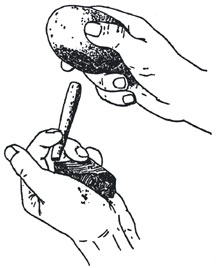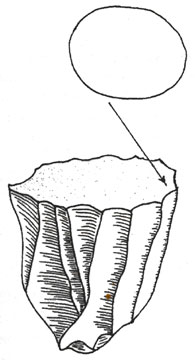 |
 |
Eleven thousand years ago Clovis mammoth hunters ranged over North American and left a record of the knapper's art in beautifully fluted spearheads, no two exactly the same. What followed Clovis and the later bison hunting Folsom tradition was much cruder, yet even these points were often well crafted and certainly functional and a pleasure to view. After the passing of the big game and the Paleo-Indian, distinctive regional cultures took form. In California it was the San Dieguito.
Malcolm Rogers made endless treks into the California deserts in search of the remains of these ancient people and discovered what was left after perhaps ten thousand years of exposure to sun, wind and rain -- rocks. Most the material culture had long since vanished. But the rocks told a story. The earliest San Dieguito preferred andesite as their medium, a volcanic rock less smooth in texture than obsidian or even flint. From this they made not mold-perfect points but crudely chipped choppers and spearheads, rough knives and percussion cracked tools whose flat surfaces resembled planes for cutting, shaving or smoothing wood or scraping hides or freeing the fiber from agave. The San Dieguito percussion-flaked stone stands in sharp contrast to the painstaking regularity of much pressure-flaked work which, though technically of the highest caliber and virtuosity, too often looks almost factory plastic and lacks the character of the ancient artifacts. It may have something to do with respect for the stone itself. The earliest San Dieguito did not use the refined pressure flaking technique at all, apparently, but simply banged stone against stone and thereby produced useful tools for millennia. Naturally fractured rock, direct and indirect percussion, pressure flaking and heat treatment -- Native Californians would in later times exploit all the wisdom of the flint knapper's art.
Unworked Rock
Rock can be surprisingly useful and beautiful just as it is. For the Miwok of the Sierra Nevada, a naturally fractured rock became a simple knife. Barrett and Gifford recorded they employed these unworked pieces to hack off hazel branches and cut maple shoots or roughly trim down a cedar bough for a bow. A simple unworked flake struck from a flint core served to scrape split maple withes for basketry or to finish the smoothing of the bow.
Percussion Technology
By the time ethnographers began asking questions, the art of flint knapping had pretty much been lost. With the great influx of Europeans and European-style goods to California in the middle of the last century, the Indian quickly replaced his stone knife with a steel blade. The accounts of flint knappng are few. Fortunately, Saxton Pope obtained some information in the early years of this century from Ishi, last of the Yahi, on the old stone-working technique.
For arrow points the Yahi used bone, flint, or obsidian, especially the latter, which was widely traded among the Indians of California. As a first step the obsidian boulder was simply shattered by throwing another rock against it. Ishi next selected one of the pieces and from it broke off large flakes in the following fashion: holding a short segment of antler or bone at a slight angle from the perpendicular against a projecting surface, he struck the top of the antler smartly with another stone and a flake would dislodge.
Flint knappers know that some stones break more evenly than others. Stones such as flint and obsidian are among the best. Moderns knappers know this is true because of the nature of the crystalline structure. Obsidian has no crystal structure. Like a fluid, applied force spreads equally in all directions, radiating like a cone with the apex at the point of impact. Rippling down and outward, the ripples actually can be seen on pieces struck from obsidian -- waves of compression in the cone of force rending the rock. Flint, on the other hand, has a cryptocrystalline structure but it is so small and fine it behaves almost like obsidian when struck with an object. Lack of large crystallized structure means that when the stone is fractured, the form of the fracture depends more on how it is struck (giving the craftsman the control) than on inherent but unpredictable structure in the stone. Both flint and obsidian and other good flint knapping materials, such as chalcedony, chert, andesite and jasper, have this vitreous (glass-like) quality and, like glass, are rich in silica. For knapping, materials must also be elastic and homogeneous. They must have the ability to snap back and be free of impurities.
Good stone breaks like glass: a direct perpendicular hit to a flat surface creates a cone of force spreading out in obtuse angles from the line of force, causing a small conical pyramid to break away, as when a bullet strikes a window. All flint knappers, ancient and modern, know instinctively from endless trial and error how fine stone breaks. The basic theory holds true for direct percussion (stone against stone), indirect (bone or another object held against stone and then struck) and pressure flaking. In order to take a thin and useful flake from a projecting surface, or platform, the blunt tip of a section of antler must be held against its edge at an angle tilting away from the vertical cliff wall beneath (which hopefully will break away and become the flake). The antler tine tilts so an edge of its imagined cone of force passes just under the vertical face of the cliff below. The antler punch is also positioned in line with a ridge on the cliff wall to make a long flake. A rounded stone about the size of a fist strikes the antler smartly. A tentative weak hit will only crumble the rock or cause a step fracture (terminating the flake too soon with a right angle break) and will not produce a long sheer flake. Too hard and the rock shatters. Step fractures can also result from too straight an angle of force, not following ridges (on the cliff wall) or improper preparation of the striking platform (it may need grinding with sandstone). Hinge fractures, a blade with a premature rounded blunt break, occur when the platform forms an angle greater than 90 degrees with its cliff wall.
The Chumash, recorded Henry Henshaw in the last century, placed the flint in the cleft of a large stone to steady it while a very hard obtusely pointed pebble of agate was held against it and struck a quick tap with a quartz rock. In this way they made knives and arrowheads.
Direct percussion requires greater skill than indirect. A deft blow with the hammerstone or a baton of thick antler is struck directly against the edge of another stone held in the hand or on the leg. It is not as accurate or reliable and the flakes produced tend to be less straight or uniform. However, direct percussion requires fewer parts, and in that sense is simpler. It was probably the only method used by the San Dieguito. Through direct percussion large broken pieces could quickly be roughed into bifaces with the shape of a crude hand ax and they could be used as such. They were convenient forms to transport and from the two roughly chipped sides useful smaller flakes could be struck as needed. Direct percussion with a hammerstone could also rough out platform cores, spearheads, knives, and arrow points. In the early 1870s Stephen Powers observed the Wiyot shaping an arrowhead in this way.
Many hammerstones used in direct percussion have been found in California archaeological contexts. They tend to be about the size of a fist, hard and compact, with wear marks indicating their use as hammerstones. Theodora Kroeber writes that for a hammerstone, Ishi was accustomed to using a water-worn boulder of heavy stone. the size and shape fit his hand well. He used it for indirect percussion against a blunt-ended piece of strong bone to remove flake after flake from an obsidian core -- long flakes for large spear points or knife blades. The core itself could be fashioned into a tool. But the hammerstone brought directly against the obsidian mass -- direct percussion -- produced smaller flakes from which Ishi made arrow points.
One hundred years ago Cephas Bard wrote of the Chumash: "Within the recollection of early American settlers now living, these natives have been known to flake off a piece of obsidian with an indescribable motion of their hands, and to dexterously sharpen its edge so that it would almost cut a hair" (Hudson and Blackburn, 1987). Undoubtedly, Bard referred to direct percussion, breaking a flake from a chunk of obsidian with a hammerstone, and refining a through the technique known as pressure flaking.
 |
 |
The article is from the book, entitled "Survival Skills of Native California" (ISBN 0-87905-921-4), by Paul Douglas Campbell. Permission to use the article on the PrimitiveWays website was given by Mr. Campbell. Paul Campbell can be contacted through his publisher, Gibbs Smith, P.O. Box 667, Layton, Utah 84041.
We hope the information on the PrimitiveWays website is both instructional and enjoyable. Understand that no warranty or guarantee is included. We expect adults to act responsibly and children to be supervised by a responsible adult. If you use the information on this site to create your own projects or if you try techniques described on PrimitiveWays, behave in accordance with applicable laws, and think about the sustainability of natural resources. Using tools or techniques described on PrimitiveWays can be dangerous with exposure to heavy, sharp or pointed objects, fire, stone tools and hazards present in outdoor settings. Without proper care and caution, or if done incorrectly, there is a risk of property damage, personal injury or even death. So, be advised: Anyone using any information provided on the PrimitiveWays website assumes responsibility for using proper care and caution to protect property, the life, health and safety of himself or herself and all others. He or she expressly assumes all risk of harm or damage to all persons or property proximately caused by the use of this information.
© PrimitiveWays 2013